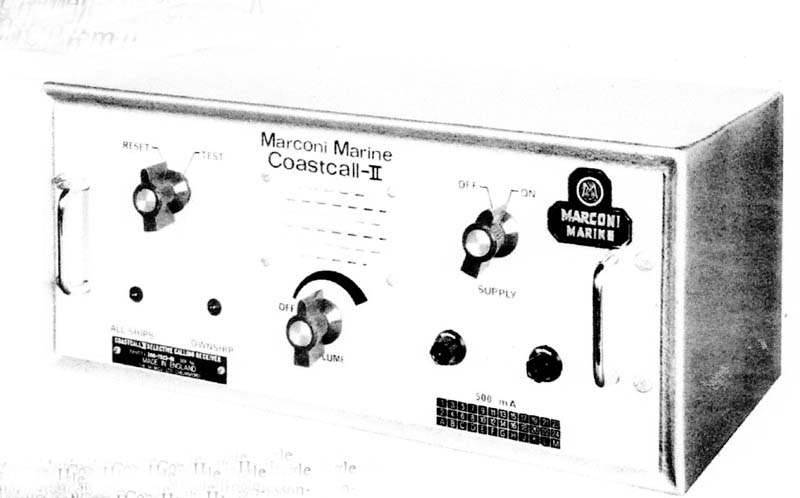 |
| Coastcall II (Image courtesy Marconi Mariner magazine) |
Contributors and Credits:
1) Ross Bradshaw [ross.bradshaw@mypostoffice.co.uk]
Type: A solid state, single channel receiver and selective calling decoder tuned to 2170.5 KHz. .
Reception Mode: A2H
Description:The use of selective calling is a marked improvement on the system whereby the coast station transmits roll calls of traffic on hand every two to four hours. This process invariably causes delays of two to six hours (perhaps longer) before a ship is aware that a message is on hand at the coast station.
When a vessel is fitted with Coastcall II, a coast station would immediately transmit the ship's selective code and alert the ship, probably within minutes of receipt of a message at the coast station. Thus. the advantages gained from selective calling can be summarized as enabling contact to be made with a ship 24 hours a day; increasing operating efficiency and providing a positive indication of a call even if {he receiving equipment is left unattended. It overcomes the disadvantage of ships having to listen to all calls and reduces the time taken by a coast station to establish contact with a ship, thereby reducing congestion on the calling channels. It also lessens the difficulties often caused by differences in language.
The decoder detects a particular series of five sequential audio tones transmitted by a coast station. Each tone corresponds to a digit of the ship's five figure identification code chosen from a set of eleven tones, which are so arranged that harmonic and intermodulation problems are eliminated. By using five sequential tones for ship identification some 100,000 combinations are possible, adequately serving the requirements of world shipping.
When the Coastcall II decoder recognizes a tone sequence which corresponds to its own prewired code, it produces an audio alarm tone and lights the 'own ships' call lamp indicating that a coast station is trying to contact that particular ship.
The Coastcall II II also responds to an 'all ships' call which is the series of eleven tones transmitted cyclically by the coast station. Upon reception it sounds an audible alarm and lights the 'all ships' lamp.
The receiver also monitors the international voice distress frequency of 2182 kHz. This frequency can be replaced by the new selective calling frequency of 2170.5 kHz if required. The output from the receiver is fed to a loudspeaker for monitoring purposes and to a decoder board.
Specifications for the Selective Calling signals are given in C.C.I.R. Recommendation 257. as defined by the XIIth Plenary Assembly, New Delhi m 1970.
Dimensions:
The receiver and decoder are housed in a single compact unit with dimensions of 6,3" Depth. x 5.5" H and 13" W.
Documentation
A complete Coastcall II manual (circa May 1977) can be found at the Internalfire web site.
Coastcall II (Image courtesy Marconi Mariner magazine)
Contributors and Credits:1) Ross Bradshaw [ross.bradshaw@mypostoffice.co.uk]
Jan 30/22